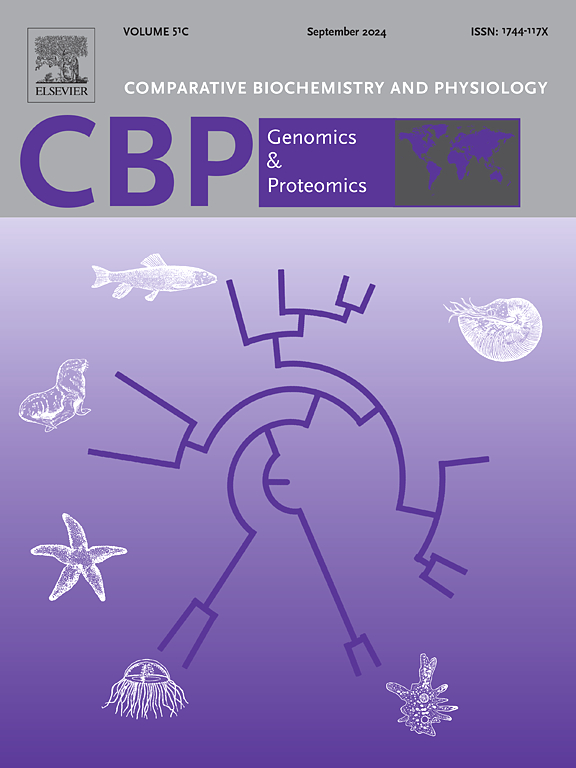与蜜蜂护理行为相关的候选腿部化学感觉基因的鉴定。
IF 2.2
2区 生物学
Q4 BIOCHEMISTRY & MOLECULAR BIOLOGY
Comparative Biochemistry and Physiology D-Genomics & Proteomics
Pub Date : 2025-05-22
DOI:10.1016/j.cbd.2025.101540
引用次数: 0
摘要
人们普遍认为,腿在昆虫的化学吸收中起着至关重要的作用。分布在工蜂腿上的化学感受器参与嗅觉和味觉探测。采用腿电图法检测不同年龄工蜂对不同化合物的反应。研究发现,高浓度的饥饿信息素可引起10日龄工蜂的电生理反应。通过RNA转录组测序,研究了护理蜂前肢、中肢和后腿中可能参与成虫近距离或接触性化学交流的化学感觉蛋白。从组装的腿转录组中共鉴定出56个候选化学感觉相关蛋白,包括17个气味结合蛋白(OBPs)、5个化学感觉蛋白(CSPs)、6个味觉受体(GRs)、3个嗜离子受体(IRs)、2个感觉神经元膜蛋白(snp)和23个气味受体(ORs)。总体而言,编码obp和csp的基因具有显著但波动较大的TPM值,表明护士腿部的表达水平较高。相比之下,化学感觉受体ORs、GRs和IRs的表达水平较低。其中,表达量相对较高的AmelOBP21、AmelCSP3、AmelOR170、AmelGR3、AmelIR21和AmelSNMP1可能在护工蜂识别幼虫饥饿信号并启动护理行为的过程中发挥嗅觉和味觉功能。这些结果为进一步研究蜜蜂腿的化学接受机制奠定了基础。本文章由计算机程序翻译,如有差异,请以英文原文为准。

Identification of candidate leg chemosensory genes associated with nursing behavior in the Apis mellifera
It is commonly recognized that legs play a vital role in the chemoreception of insects. The chemosensilla distributed on the legs of the worker bee Apis mellifera are involved in olfactory and gustatory detection. The responses of worker bees of different ages to various compounds were detected using an electrolegogram test on the legs. It was found that a high concentration of the larval starvation pheromone ocimene could trigger electrophysiological responses in 10-day-old worker bees (nurses). Through RNA transcriptome sequencing, the chemosensory proteins in the forelegs, middle legs, and hind legs of nurse bees that may be involved in adult close or contact chemical communication were studied. A total of 56 candidate chemosensory-related proteins, including 17 odorant-binding proteins (OBPs), 5 chemosensory proteins (CSPs), 6 gustatory receptors (GRs), 3 ionotropic receptors (IRs), 2 sensory neuron membrane proteins (SNMPs), and 23 odorant receptors (ORs), were identified from the assembled leg transcriptome. In general, the genes coding for OBPs and CSPs had significant but highly fluctuating TPM values, indicating high-level expression in the legs of nurses. In contrast, the chemosensory receptors ORs, GRs, and IRs showed low-level expression. In particular, AmelOBP21, AmelCSP3, AmelOR170, AmelGR3, AmelIR21, and AmelSNMP1, which were relatively highly expressed, may play olfactory and gustatory functions in the process of nurse bees recognizing larval starvation signals and initiating nursing behaviors. These results lay a foundation for further research on the chemoreception of legs in the honey bee A. mellifera.
求助全文
通过发布文献求助,成功后即可免费获取论文全文。
去求助
来源期刊
CiteScore
5.10
自引率
3.30%
发文量
69
审稿时长
33 days
期刊介绍:
Comparative Biochemistry & Physiology (CBP) publishes papers in comparative, environmental and evolutionary physiology.
Part D: Genomics and Proteomics (CBPD), focuses on “omics” approaches to physiology, including comparative and functional genomics, metagenomics, transcriptomics, proteomics, metabolomics, and lipidomics. Most studies employ “omics” and/or system biology to test specific hypotheses about molecular and biochemical mechanisms underlying physiological responses to the environment. We encourage papers that address fundamental questions in comparative physiology and biochemistry rather than studies with a focus that is purely technical, methodological or descriptive in nature.

 求助内容:
求助内容: 应助结果提醒方式:
应助结果提醒方式:


